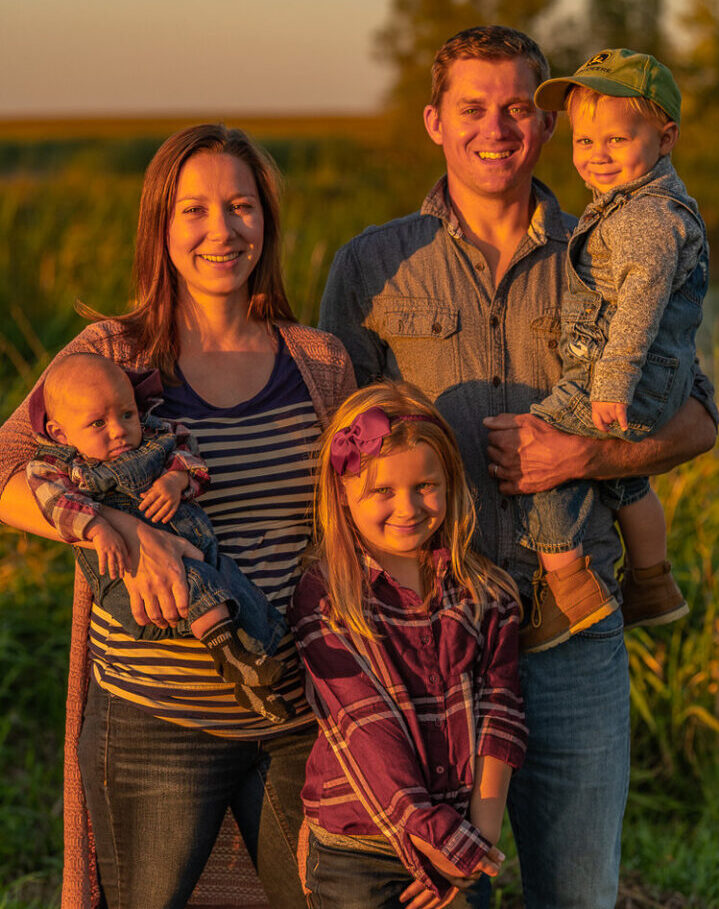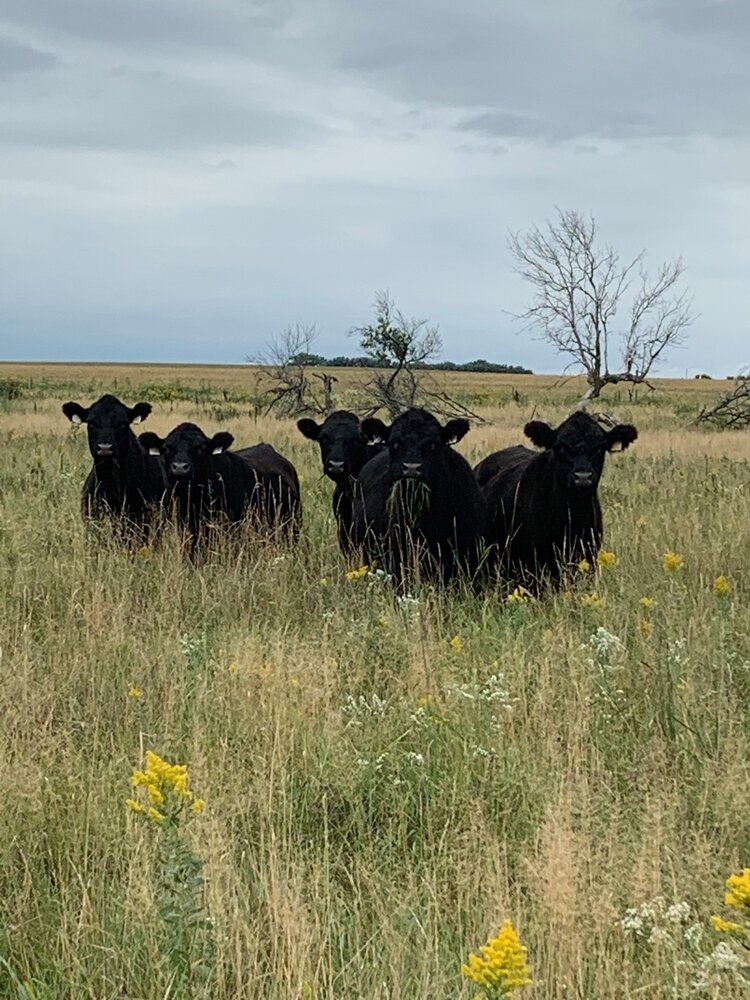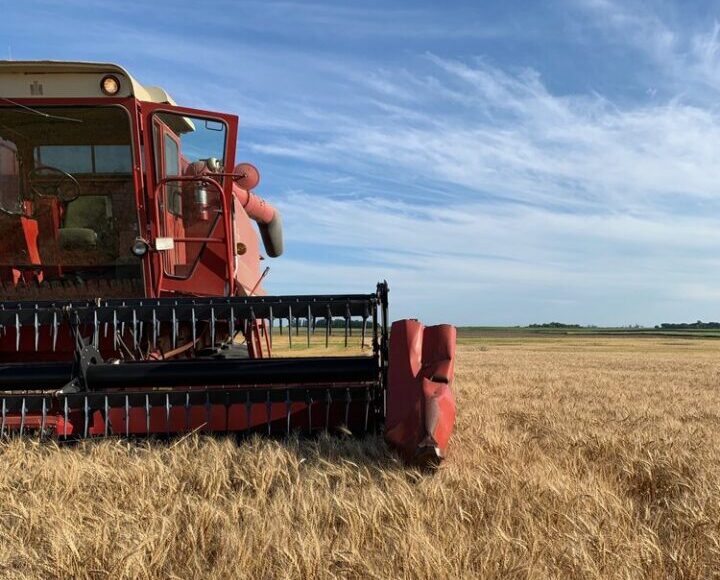August 6, 2020 – Luke and Ali Peterson became partners in A-Frame Farm in 2016 with farming mentors, Carmen and Sally Fernholz in Madison, Minnesota. Today they farm 500 certified organic acres employing practices such as cover cropping, minimal tillage, and crop-livestock rotation with the goal of becoming self-sustaining and truly regenerative.
Prior to farming, Luke spent several years working with the Minnesota Department of Natural Resources. After the birth of their first daughter, Luke wanted to find a way to spend less time on the road and more time at home with the family. Both Luke and Ali shared a growing desire to restore the environment, help mend a broken food system, and build strong community. Ali continues to work full-time as a nurse practitioner.
While at the Department of Natural Resources (DNR) doing prairie restoration, Luke says he worked with a pretty unique group of people with backgrounds in environmental science and related fields. “Working with them, my eyes were opened to how destructive agriculture can be. I learned a lot and did research on how our natural ecosystem used to function on its own. I got really interested in it when I started learning about how that ecosystem actually created more meat protein when nobody was farming. Things like that made me very curious.”
“We started buying old machinery, got a small fleet of equipment and began farming conventionally. Two years into it, I began selling seed for a local co-op for Monsanto and some of the big companies. Being involved with that business really opened my eyes to agriculture as get big or get out. I started thinking about how I could fit into this world of two extremes—one is trying to produce as much food as possible no matter what the cost and the other (from the DNR) is preserving land and not letting anybody use it. They were two opposites. I decided organic farming would be the best solution. I still wanted to grow food and I loved farming. I learned that corn and soybeans weren’t necessarily even food and that was kind of personal to me and bugged me quite a bit. So that pushed me into organic farming.”
The farm was transitioned to organic in 2014. “Ever since then we’ve been educating ourselves more and more and we have a very diverse crop rotation,” says Luke. They’re planting more perennials and introducing a grass-fed beef herd. “We’re taking some row crops out of production, introducing grass-fed beef and then rotating that throughout the farm for our fertility source. So, we went from conventional to organic, and now that we’re organic, we want to become truly regenerative.”
Luke says the transition to organic isn’t easy. “Money is always a challenge when you’re starting a new enterprise and three years out from seeing any return. My wife’s job as a nurse practitioner allowed us to pay the bills.” What’s his best advice for new farmers? “Find a mentor and connect on social media with other farmers.”
Luke was lucky because his neighbor has been farming organically for forty years. “Any time I had a question I could ask him and he had all this experience that he was willing to share. That’s another reason I was successful. I never really had any crop failures like a lot of beginning organic farmers have because I was given all that information right off the bat.” Going to MOSES made a big difference as well and YouTube has been really helpful. “There’s a lot of pretty incredible farmers out there,” says Luke. “And they are willing to share both their successes and failures to help others learn.”
What does Luke mean when he says truly regenerative? “We use a lot of regenerative practices but I still wouldn’t say we are regenerative because we import fertility from off the farm. I think the main thing is supplying your own fertility. It forces you to do a lot more intense soil health practices that you don’t have to do if you just bring in your nutrients.”
Diversification is the name of the game for Luke and he’s constantly on the lookout for new opportunities. The relationships he’s set up with local bakers to sell his small grains provide the income that allows him to incorporate soil health practices like cover cropping and diverse crop rotations, introducing perennials like Kernza and alfalfa. “We’re selling all of our small grains locally and working to build a marketplace where we can have long-term relationships with people,” Luke explains. “We’re new at this so we’re negotiating a price that works for everyone.”
“We sell our corn to a local organic hog farmer and our soybeans to Blue River Hybrids as seed. Seven Sundays is a new company in Minneapolis that I’m growing buckwheat for this year. There’s only so much you can do with the main staple crops, and they’re long season. I’m working on finding businesses that want a unique crop other than what the general market wants. That’s the lever I need to move my farm towards being regenerative because every time I can add a unique crop, I can be a lot more creative. The buckwheat is short season, which means I can plant cover crops prior to the buckwheat in the fall, graze that for fertility, and then plant winter wheat. It’s kind of the opposite of corn, which takes a lot of fertility, and makes it hard to get a cover crop in and graze it. Corn also involves more tillage, which the buckwheat doesn’t.”
“We eliminated all tillage in the fall and the only tillage we do is to terminate a perennial that’s been in the soil for three years or more because we either have to use tillage or a chemical. And we don’t do any fall tillage on our corn, soybeans, or small grains in the fall. In the spring we do a light pass with a field cultivator, two inches deep, to prepare a seed bed. Once our row crops are up, we do have to cultivate as well. It’s tillage, but very shallow, minimal disturbance.”
When it comes to building soil health, Luke says the changes they’ve made have yielded impressive results. “We stopped the deep tillage four years ago and two years into it, it was starting to blow our minds the soil textures we have on our farm compared to before. We’ve also been pretty aggressive on the cover crops and between the two of those things, our soil has become much more alive and much more forgiving. It’s amazing the mentality we used to have about tillage, that it would warm up and dry out your soils faster in the spring. Honestly, nothing could be further from the truth. We get out in the fields as soon as our neighbors who are doing the deep fall tillage. Our soil temperatures are the same temperature if not higher. We think it might have something to do with the microbial life, that it is actually heating things up. There is more activity and more air in between the soil particles. When we do have a 70-degree day, it captures that heat better.”
Luke says these practices, along with the livestock benefits and really pushing the rotation by marketing as best he can to find alternative crops will allow him to become more flexible, self-sustaining, and truly regenerative. “We are very disconnected from our food system and the pandemic has brought this to light. I’m creating my own branding and using social media to tell people what I’m doing every day and why I’m doing it. Consumers buy what’s available at the grocery store and it’s up to us to put something different in front of them.”
You can learn more about A-Frame Farm on their website and follow them on Instagram at @aframefarm.





